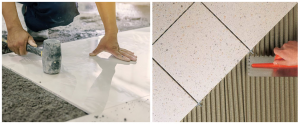Ceramic Tiles vs Natural Stone

Ceramic Tiles or Natural Stone
The purpose of this article is not to examine the advantages or disadvantages of stone and ceramics. Its purpose is to make the best choice between stone and ceramic in the interior of the building (use of floor and wall) for you in a brief, concise and useful way.
What you will read on this page:
- Comparison of stone and ceramic in terms of price
- Comparison of stone and ceramic in terms of beauty
- Comparison of stone and ceramic in terms of variety of color and design
- Comparison of stone and ceramic in terms of lifespan
- Comparison of stone and ceramic in terms of slipperiness
- Comparison of stone and ceramic in terms of weight and installation
- Comparison of stone and ceramic in terms of price

Comparison of stone and ceramic in terms of beauty
The undisputed and fair winner of this competition is the stone. Due to its naturalness and completely smooth and polished surface up to the border of the edges, without distortion or wave, the stone has a natural beauty and twice as much as ceramic. The unique design of each stone tile creates a beautiful effect in the work, especially in high sizes.
In recent years, ceramics are offered with the greatest similarity in large dimensions and slabs and even in the form of book match or various faces. To be honest, it is not easy to distinguish whether it is ceramic or stone from a few meters away. However, the energy and spirit of natural stone cannot be compared with handmade ceramics.
Perhaps by putting a stone and ceramic tile together, ceramic is the winning option in your opinion. But this comparison should be measured in real terms. Real conditions mean installation and observation of work results in the worked area.
Stone is generally more expensive than ceramic. This can vary depending on the type of stone. Of course, there are cheaper stones than ceramics, which are among the cheapest stones. The advantage of ceramic to stone regarding the price is the clarity of the price of this product in the market. While stone can be offered at different prices in different cities depending on the type and grade. Therefore, we consider ceramics to be the winner of this competition.
Comparison of stone and ceramic in terms of variety of color and design
Stones have a much higher variety than ceramics. But the point is that not all stone designs are easily available everywhere. For this reason, in general, ceramic designs and colors can be considered more diverse. But if the mentioned limitation is not in use, surely the stone is the winner in this competition without any doubt.
The reason for this can be seen in the naturalness of the stone. Think for a moment that a factory as big as the earth produces an unlimited number of stone designs, only some of which are discovered and extracted by humans.
Comparison of stone and ceramic in terms of lifespan
The winner of the longevity competition (use of the floor) cannot be considered stone or ceramic because it depends on things like quality, dimensions, type of use, etc.
For example, in terms of water and oil absorption, ceramic is generally the best option. Or, in terms of wear and bending resistance, ceramics are sometimes better than marble stones. But this depends on the type of stone and ceramic. But obviously, in the case of stone, you can give another life to the stone by dragging the sandpaper on the surface so that it becomes shiny and clean like the first day.
Comparison of stone and ceramic in terms of slipperiness
We talk about slipperiness when the coating surface is glazed and shiny. In this case, the ceramic is called polished or glazed, and the stone is called polished. Glossy ceramics have a very slippery surface in wet conditions. However, most stones (especially marble) are not slippery due to their texture.

Comparison of stone and ceramic in terms of weight and installation
The undisputed winner of this comparison is ceramics. Because the stones, no matter how accurately they are cut, are not as accurate as ceramics (length, width, thickness, and smoothness of the cuts). Also, the weight of ceramic is relatively lighter compared to stone.



